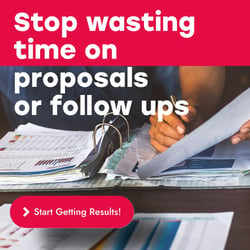Want sales success? Developing a solid, full-proof B2B sales strategy is step #1.
That being said, we've already given you the most effective tool to develop a can't-fail strategy... It's our simple and straightforward B2B Sales Strategy Framework.
If you use the framework as a guideline to develop your own strategy, then you've got exactly what you need and nothing of what you don't do to develop and perfect your own ideal B2B strategy!
However, there are several common mistakes that sales teams make when following the framework. Not only that, but there are several aspects of the framework that sales teams regularly don't develop to their full potential. It’s as if they’re leaving money on the table!
To help prevent those common errors and fill in the gaps for potential, we're sharing the most important do's and don'ts to take into consideration when developing your strategy.
Take these points into consideration in order to instantly remove major hurdles to sales success.
Considering these do's and don'ts is perhaps the simplest way to prevent silly errors and mishaps with your strategy. And while they're simple considerations, they can make all the difference in your overall business success!
Why Is Having a Sales Strategy So Important?
If you're going to invest a significant amount of time and energy into something, you've got to have an important purpose for doing it, right?
For example, if you're going to pull an all-nighter to study for a final, it better be because you have a dream of getting into a top-notch grad school, or at least the goal of getting an A in the class, right?
Similarly, you wouldn't choose to dive head first into sales without having a compelling 'why' for doing it.
And when it comes to sales, the B2B sales strategy defines your 'why' or purpose for why you do what you do. By that, we mean that the strategy:
- Defines a 'why' for the 'what' (the 'what' being the B2B sales process)
- Explains your purpose for being in business in the first place
First off, consider your sales process the 'what' when it comes to sales. It describes all the actions you take, from lead generation to final sales pitches, to close deals. The sales process gives you an important 'why' or purpose for each step of the process.
Second, when it comes down to it, sales is all about service. It's about having a vision for a better world and coming up with a solution to manifest that vision. More specifically, it's about noticing a problem in the B2B business world and coming up with a solution to solve it. Moreover, all of B2B sales begins with a grand 'why' or purpose which is outlined in the sales strategy. In fact, every successful entrepreneur will tell you that their achievements began with a 'why'!
Bottom line... A B2B sales strategy is important because it lays the foundation for your sales success. If there is no foundation, there is no success!
1. Digging Into Your Company’s Vision Statement
The first phase of the sales strategy framework is digging deep into your company’s vision.
Many business leaders underestimate the importance of this step. They see it as a pointless creative brainstorming tactic, rather than the strategic planning tactic it is.
The truth is that visions are the bedrock of every successful business that exists!
Therefore, check yourself! Take this first step seriously if you want the next four phases of the strategy framework to fall into place.
DONT: Mimic Somebody Else’s Vision
The most impactful visions are the ones people have never seen before.
No B2B company ever knew they needed a CRM until some entrepreneur had a vision for a future in which every business had perfectly organized and refined sales systems.
That being said, carbon-copying somebody else's vision won't get you far.
HOWEVER, that isn't to say that you can't refine or improve upon somebody else's vision.
For example, maybe you aren’t the first person to think of a CRM, but maybe you have a vision in which CRMs are easier to operate and have a much smoother user experience.
Moreover though, when developing your vision, the goal is to make it as authentic as possible!
DO: Think Bigger!
How many times have you faced a business-related challenge and somebody told you something along the lines of, 'Maybe it's not working because you're thinking too big' or 'You should start by thinking smaller'?
If you've heard anything like that before, consider this... Maybe the reason you're facing a challenge or your idea isn't working out is because you're thinking too small.
Maybe your vision deserves to be scaled higher, and will only work out on a large-scale basis.
That being said, it's time to stop thinking small and start thinking big!
Important visions deserve big platforms. Therefore, if you have a vision that you believe will help positively change people's lives, then start thinking bigger!
DO: Be Concrete
While digging into your company's vision involves a lot of creative brainstorming, that doesn't mean that it isn't concrete. You need to lay the foundation for those visions to come to life.
By that, we mean that you need to write down the details of your vision and be as specific as possible.
If you aren't concrete with your visions, the odds that they manifest decrease significantly.

2. Developing Your Unique Value Proposition
Once you've got your vision set in stone, the natural next step is to develop your unique value proposition (UVP).
The UVP embodies your company's vision and differentiates you from your competition. It's the thing that makes your customer base stand up and say, 'Yep! They're different from all the other options in the market'.
Whatever your UVP is, make sure that it's unique to your business and embodies the spirit of your vision.
DONT: Mimic the Competition
Just like with your company vision, don't try to mimic or copy your competition's unique value proposition.
Because, at the end of the day, the unique value proposition is supposed to highlight what makes you, well, unique!
If you find yourself wanting to copy somebody else's value, there's a good chance you're dealing with an all too common problem in business: The fear of failure.
When we fear failure, our brains tell us to back into a safe zone. In this case, the safe zone is a place where you blend in with competitors, because it's simply much safer to blend in than it is to stand out.
Furthermore, fight your fear of failure to prevent blending in with your competitors and drowning out what makes you unique.
DONT: Get All Sales-y
When developing your UVP, don't go classic sales mode on your future customers.
By that, we mean that if your UVP includes phrases like 'The best ever' or 'Never before seen', then you've probably sunk to the level of the used car salesperson that everyone avoids at all cost.
The truth is that prospective customers don't want to feel like they're being 'sold to'. And, sales-y phrases make them feel just that.
Avoid going full-on used car salesman on your customers at all costs!
DO: Think Deeply About Your Company Values
Here's an important question for you: If your business was a person, what would they stand for and value above all else?
Is it exceptional customer service, low price points, or environmental sustainability?
Whatever the answer, those values must be reflected in the UVP.
Because, at the end of the day, B2B buyers literally purchase from companies as if they were people. They have a look at what the business stands for, and then make a purchasing decision based on that.
Pretend as if your business is an independent person with its own values, and then align those values with your UVP!
DO: Clarify Your Selling Point
Your UVP must be crystal clear! The moment that potential customers look at your sales and marketing content, they should know what makes your company special.
That being said, get your sales and marketing teams together to highlight and hone in on the UVP in the sales and marketing strategies.
Instead of coming up with over-the-top strategies, focus on making that UVP as clear as possible in every piece of sales and content marketing you create.
Bottom line: An unclear selling point isn't a good one. If your customers can't pinpoint what makes you unique right off the bat, then you need to go back to the drawing board.
3. Developing Your Ideal Potential Customer
So... You've got a vision and unique value to bring to the table. Now, who is going to buy it?
This next phase of the strategy framework is all about clarifying who your ideal customer is. By that, we mean developing an ideal prospect profile (IPP) for the B2B company and an ideal buyer persona (IBP) for the decision-makers at the company.
At the end of the day, you can have the most valuable product or service and admirable business vision in the world, but none of it matters if you have nobody to sell it to!
DONT: Forget About the Prospect’s Emotions
The whole purpose of being a sales rep is to help solve customer needs with your product or service.
However, customer needs span beyond just the tactical pain points.
We've talked about it many times before here on the Business Growth Insider but we will say it again: Prospects base their final decision-making on emotional needs rather than tactical needs.
Once they believe that your product or service will help solve their specific pain point, emotions are what put them over the edge to make a buying decision.
Therefore, when developing your ideal potential buyer for the top stakeholder, don't forget to identify their emotional needs!
DONT: Neglect Customer Relationships
Relationships. Relationships. Relationships! B2B sales is about building relationships with potential and existing customers!
Unlike in business-to-consumer sales, building and fostering long-term relationships with customers is central to success.
That being said, when putting together your IPP and IBP, think about the kind of customer who you would have a great relationship with.
Particularly, think about the kind of person you would have a friendship with... What specific traits would motivate you to be friends with them? If you're like most people, it's that they share similar values with you and have corresponding personality traits.
Think about the traits of someone you would hold a solid relationship with and then incorporate those traits into your IPP and IBP. Because, believe it or not, but great business-to-business relationships are usually based on many of the same qualities of regular friendships!
-min.png?width=900&name=1%20(1)-min.png)
DO: Put Yourself In Your B2B Customer's Shoes
Want to know one of the most powerful skills one can have in both sales and life?
It's being able to put yourself in somebody else's shoes to see life from their perspective!
When it comes to sales, having this skill gives you a much clearer picture of your customer's needs, both tactical and emotional. Once you hone in on those needs, you have a much clearer idea of exactly how to convert them from prospect to current customer!
DO: Get Technical, Be Specific
The more specific you get with your ideal customer, the better.
However, not all sales reps like to get more specific because, as a result of doing so, their potential customer pool decreases. They begin with a big pool of customers, refine their IPP and IBP, then all of a sudden their customer pool gets much smaller.
If this sounds familiar to you, just know that it's better to have a smaller pool of potentially perfect customers than a large pool with many 'eh' customers.
While it might be initially discouraging to see your pool shrink, quality customers should always trump quantity. In the end, you'll save yourself a lot of time and energy by focusing on the right people who truly are a good fit for you.
4. Creating Your Brand Message
Phase four of the strategy framework is the culmination of the first three phases. More than that, it's the peak of the entire strategy!
Think of the brand message as your first impression in sales. And, as much as we all hate to admit to ourselves sometimes... first impressions matter!
Once you make that first impression, whether it be on social media or email outreach, it will stick in the prospect's mind for the entirety of their buying process.
Have we emphasized enough the importance of the brand message?
DONT: Forget About the ‘How’
Remember, the first 50% of a message is the content, and the second 50% is how you deliver the content. Believe it or not, but how you deliver the content is more important than the content itself!
Why?
Because... How you say things tends to dig at people's emotions more than the content itself.
For example, I can say to you, 'You made me upset when we were talking', but it has the effect of backing you into a corner and making you feel threatened.
Alternatively, I can say, 'I didn't feel good after we spoke'.
In both statements you're sending the same message, but the second one is less confrontational.
Unfortunately though, far too many salespeople spend all their time on content and very little on delivery. As a result, the message doesn't sit well with their potential customers.
Remember the days when your parents would tell you, 'It's not what you say but how you say it that matters?'. It turns out... they were right!
DONT: Think Small-Scale
Just like your company vision, don't be really afraid to go there with your brand message!
By that, we mean don't be afraid to personify it, and really make it the kind of message you want it to be.
When it comes to the brand message, scaling back will seriously hurt you. Don't be afraid to just go for it!
DONT: Forget About Your B2B Marketing Team
Keep in mind that sales and marketing are intricately connected.
Therefore, given that the brand message is so important, make sure that your marketing team is also in on the brand messaging game.
That way, they can spew the message everywhere via inbound pathways like content marketing and outbound pathways like email blasts.
Whatever content the marketing team puts out there should scream the brand message!
DO: Align Your Company Brand With Your Personal Brand
Here's something fun every B2B sales team member can do... Have everyone hone in on their own personal brand in order to align it with the company brand.
When sales team members interact with target customers, they act as the face of their company. Therefore, it's important that team members don't just put their own personal brand on display, but that it points back to the company brand as well.
For example, if your company brand is all about liveliness, positive energy, and amazingly personal customer service yet a team member's personal brand is more on the old-fashioned, highly-professional grey-suit side, are they really aligning themself with the company brand?
Definitely not!
That being said, get all your team members together to do some personal brand development.

5. Setting the Stage to Develop Your Sales Process
With a solid strategy that highlights your brand message, you're now ready to lay the foundation for your sales process.
The process is your plan of attack to get prospects in the door and convert them to paying customers. AKA, this is where the real action starts!
But, before hitting the gas pedal, consider these do's and don'ts. Unfortunately, when it's time to take action, the fear of failure begins to manifest in many sales reps. While they were confident before, all of a sudden the idea of creating a plan of action has them backing into a corner of fear.
That being said... Stay conscious of your mindset, because when the fear of failure backs you into a corner, you become less assertive. And when you aren't assertive, then you might as well forget about sales success.
Now that it's time to set the stage for your plan of action, don't be afraid... be assertive!
DONT: Neglect the Buyer’s Journey
Keep in mind that there are two sides to sales, including:
- The backend sales pipeline (AKA sales process/sales cycle) that sales reps see
- The user interface sales funnel that your target market goes through
That being said, your backend might look good to you, but is it producing the best possible user interface for your target customers?
The goal with the sales funnel is to take prospects on a buying journey... It's not just a matter of checking boxes and hopping from one sales event to the next. Rather, it's a journey of growth in which emotions are revved up, stories are told, and relationships are built.
Put yourself back in your customer's shoes to determine whether or not your user interface is sloppy or an exciting, event-filled journey.
DONT: Elongate Your Sales Pipeline
Speaking of your user interface... If your sales pipeline is exceedingly long and filled with several unnecessary steps, then your sales funnel will inevitably be long winded. And, there is not a single potential customer in the world that enjoys a long winded funnel!
Not only that, but the longer your pipeline is, the more complex it becomes. And the more complex it is, the greater the odds that mistakes are made!
To put it simply: Developing extra long sales pipelines is like asking for major trouble.
Therefore, make sure to stay on track with our complete Sales Process Flowchart to keep it in check!
DO: Take Advantage of Easy Sales Tools
When it comes to sales, sometimes the most effective sales tools and tactics are the easiest ones to use. So if you're not taking advantage of them, then you're seriously missing out.
For example, social media is one of the most effective sales tools to generate inbound leads. More specifically, sharing case studies and current customer content on LinkedIn is a great way to get prospective customers sliding into your DMs.
The next time you log on to your personal LinkedIn, share one of your current customer's posts and caption it about how happy you are to see their business success. It literally takes minutes to do but can literally open the floodgates to potential new customers.
DO: Divide Up the Sales Cycle
Lastly, give every member of your sales team a step of the sales process to be in charge of based on who has the right skills for that step.
For example, whoever is best at cold calling and emailing should obviously manage outreach, while whoever is best at closing deals should take the final sales pitch.
Dividing up the cycle according to sales rep's skills improves efficiency and increases the odds of getting signatures on dotted lines.
Final Thoughts On Do’s & Don’ts of the B2B Sales Strategy Framework
A sales strategy is the bedrock of your sales potential because it is the foundation of all things sales-related! That being said, your sales strategy needs some serious love and attention.
By love and attention, we mean you need to do two specific things:
- Use our framework as a guideline to develop your own unique strategy
- Follow our do's and don'ts to prevent common strategy mishaps and make the most of the framework
Bottom line... Your sales potential is in your hands alone! While B2B sales certainly comes with inevitable challenges, that doesn't mean that it needs to be exceedingly difficult.
Eliminate pitfalls and make the most out of your strategy to achieve all of your sales goals (and more)!
You May Also Like
These Related Articles

5 Signs You’re Overthinking Your B2B Sales Strategy

The B2B Sales Strategy That Leading Sales Pros Live By




